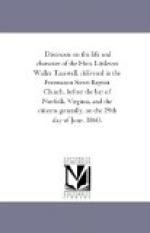The orthography of Tazewell, like that of the earlier Norman names which were forced to float for centuries on the breath of the unpolished Anglo-Saxon, has been spelt at various times in various ways by members of the same family, and in various ways in the same writing; as the name of Shakspeare, though a plain Anglo-Saxon name, was spelt in four different ways in his will. Thus, in the parish register of Buckland Newton, in the county of Dorset, the name is spelt in four different ways; and one of the spellings, which is still popular in England, is Tanswell, and opens up to us the true original of the name in Tankersville, the name of one of the knights who came over with William the Norman, and whose name is inscribed on the roll of Battle Abbey. The process was evidently Tankersville, which, contracted, and marked by the apostrophe, became Tan’sville; and, as the Norman blood became, in the course of centuries, more intimately commingled with the ruder but steadier Anglo-Saxon stream, the Norman ville gave way to the Saxon well, and Tan’sville took the form of Tanswell; and Tanswell and Tazewell, variously spelt, have been used indifferently by father and son of the same family for more than three hundred years, and are so used at the present day.[1] The late Mr. Tazewell thought that his name was originally spelt Tazouille, and that the ancestor emigrated from France to England before the revocation of the edict of Nantes, and I leaned to this opinion on another occasion; but, apart from the absence of all evidence to sustain this opinion, it is now certain, from the autobiography of the Rev. William Tazewell, translated from the original Latin by his grandson, the Rev. Henry Tazewell, Vicar of Marden, Herefordshire, and published by the Camden Society in 1852, that the family of Tazewell flourished in England at least a century before religious disputes drew to a head in the reign of Louis the Fourteenth. I have been particular in stating these facts, as they illustrate the history of races, especially of those races which composed the people of Virginia at the date of the Revolution; and it is something to know, that a descendant of one of those men, who, under William the Conqueror, wrested the empire of England from the successor of Alfred, and trod down beneath their iron hoofs the Anglo-Saxon people, aided in rescuing the colony of Virginia from the tyranny of George the Third, the inheritor of the blood as well as of the crown of the Norman robber.




